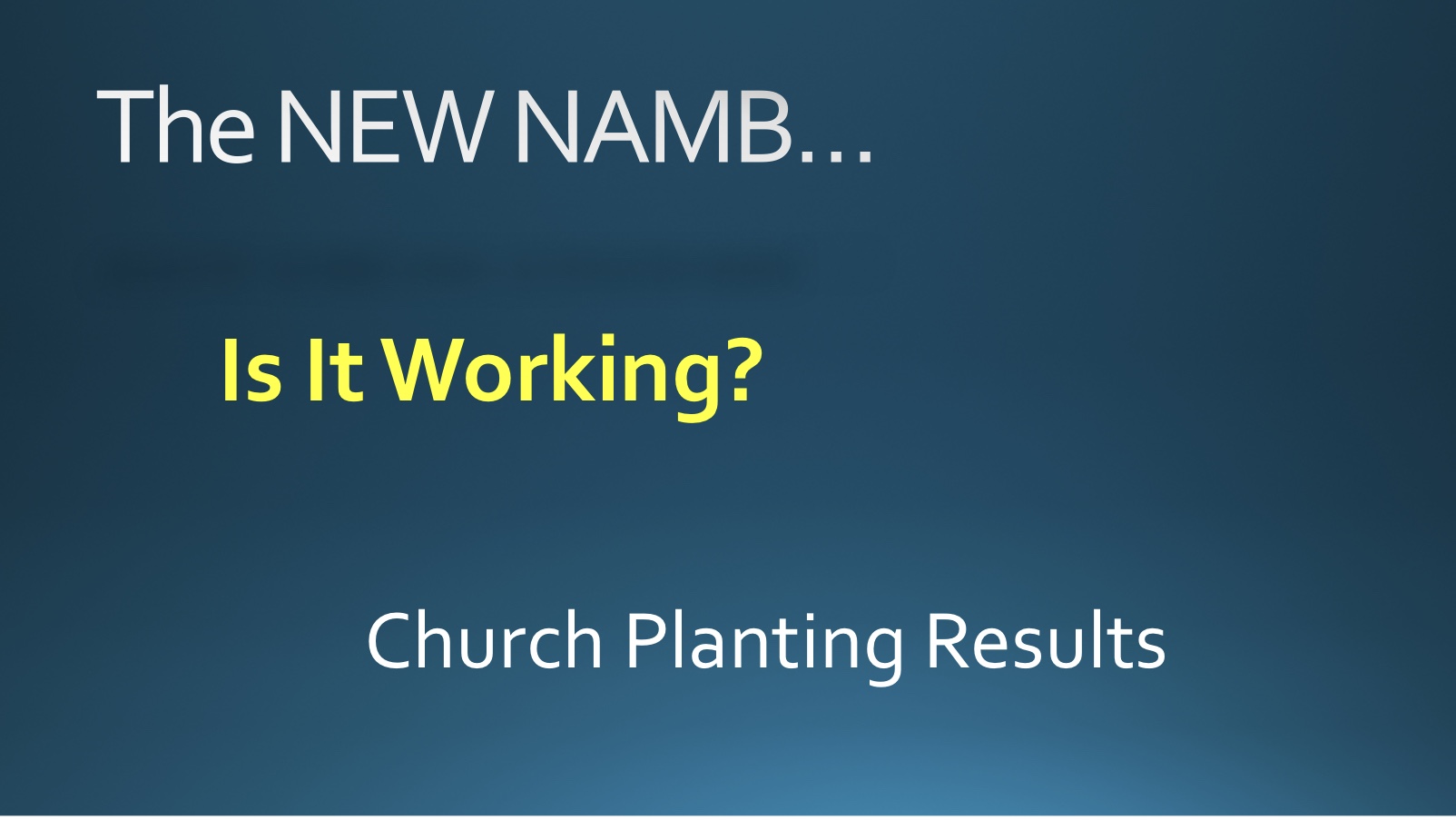When it comes to Southern Baptist church planting, strategic matters cannot be addressed in soundbites or 140-character Tweets. One must first gain a wider and deeper understanding of the issues. I began my exploration in a PhD seminar on the History of SBC Evangelism in 1989 at New Orleans Baptist Theological Seminary. I had the privilege of reviewing the dusty SBC Annuals and tracing SBC church planting from its earliest roots to determine its impact upon evangelism.
In 2010, Southern Baptists went “all-in” with church planting as our sole evangelism focus. This approach radically impacted NAMB, State Conventions, Associations, and practically everything and everyone engaged in SBC evangelism.
This essay is the third part of a series entitled The New NAMB—Is It Working? Throughout this series, we are exposing the questions being asked by NAMB as weaker questions than the better questions we are asking. Today’s “better question” is this one: What are the numbers and types of church plants and what are the evangelistic results of these plants?
Affirmations
Virtually all Southern Baptists strongly affirm the ministry of church planting, the missionary role of church planters, and the provision of reasonable measures to assess, train, and deploy planters into their mission fields. The New NAMB has brought greater awareness of these benefits, sought to engage partnering churches, and increased the overall value for church planting among SBC pastors and leaders. We are grateful and celebrate that there are plants which are impacting their local ministry contexts. Lives are being changed and the gospel is reaching new people.
Flawed Fundamental Assumption
However, this New NAMB focus on church planting was built on the statistically faulty belief that church plants are 3-4 times more effective in evangelism than established churches. The communication of this fact with baptism ratios based on membership was and continues to be either statistical ignorance or intentional deception in order to sell this approach to Southern Baptists.
The origins of this flaw are found in the Great Commission Resurgence Task Force report adopted by SBC messengers. The statistic cited above was used to convince Southern Baptists to go “all-in” with church planting. This has proven to have unintended consequences in evangelism, partnership, associations, and state conventions.
Consider the following example. An older established church averages 100 in worship, has 300 members, and baptizes ten people. A new church plant averages 100 in worship, has 50 members, and baptizes ten people. Notice the only difference is a membership of 300 for the existing church and 50 for the new plant. Using the flawed approach of the baptism-to-membership ratio, we would reason that new churches, with a ratio of 1 to 5, are performing six times better than existing churches, with a ratio of 1 to 30. However, using the legitimate comparison of the baptism-to-attendance ratio, we would reason that new church plants and existing churches are performing precisely the same, each with with a ratio of 1 to 10.
Do you see the problems caused by national leaders sharing misleading statistics with Southern Baptists? Do you see the problems caused by building an entire national strategy off of only one misleading statistic? This glaring mistake has deeply damaged large portions of the SBC and hindered our evangelistic effectiveness.
The Cost of our Flawed Strategy
The cost to adopt this approach has been enormous relationally, financially, evangelistically, and in terms of staffing and partnering with local, state and national SBC entities. As one State Executive said, “Partnership is dead in the SBC.” Terminating 37% of NAMB staff in the first eight months of Ezell’s tenure not only removed those staff members, but also removed all the relationships and goodwill they had built up through years of service to various NAMB partners at the local, state, and national levels.
The evangelistic effectiveness of Southern Baptists has been on a sharp and steady decline during the years of this emphasis. Consider just three statistics regarding our baptisms as we compare the Former NAMB Era (FNE) of 2004-2009 with the New NAMB Era (NNE) of 2010-2015.
- SBC Total Baptisms declined by 13% from the FNE to the NNE.
- SBC Baptisms declined by an average of 45,289 per year from the FNE to the NNE.
- SBC Baptisms per church declined by an average of 18.7% during the NNE.
Under the New NAMB, each year we are investing in church planting 3.5 times more Southern Baptist dollars than we were investing under the Former NAMB—76.1 million in 2017 compared with $20.9 million in 2010. In spite of spending 3.5 times more money, the New NAMB is actually starting fewer churches per year than we were starting previously, as discussed in the next section. In 2017, the NAMB Church Planting Budget of $76.1 million is more than twelve times greater than the NAMB Evangelism Budget of 6.3 million.
Under a new project, the New NAMB is budgeting $62 million to purchase homes for church planters over a period of six years. NAMB has already purchased 89 such homes. This move into owning and managing property for planters has not been noted by this writer in the history of the SBC. In 2017 alone, the $12 million budget for purchasing church planter homes is nearly twice as much as the $6.3 million NAMB budget for evangelism.
Other costs have impacted evangelism dollars and staff. NAMB virtually eliminated all national evangelism staff specialists, defunding State Directors of Evangelism and other state evangelism staff in non-Southern states, reducing the NAMB evangelism budget from $20.6 million in 2009 to $6.3 million in 2017, and cutting off funding for various regionally effective evangelistic ministries. Previously, these jointly funded evangelism staff positions in non-southern states served both the planters and the existing churches who fund NAMB and develop missionaries serving North America.

Charting Our Decline in the Number of SBC Church Plants
The New NAMB had a church planting goal of 1,500 per year before revising it down to 1,200. However, the New NAMB has averaged 924 plants per year. During the six years prior, NAMB averaged starting 1,368 churches per year—even after adjusting downward the inflated number reported, which included not only SBC Church Plants, but also already existing Non-SBC churches who chose to affiliate with the SBC during that year. Based upon these calculations, the SBC has been planting 444 fewer churches per year in the New NAMB Era, despite our investment of 3.5 times more money.
- Former NAMB Era (2004-2009) Church Plant Total—8,211
This church plant total takes into consideration an estimated 1,150 churches previously included in this total that were not really SBC Church Plants at all, but merely existing non-SBC churches that chose to affiliate with the SBC during these Former NAMB Era years.
- New NAMB Era (2010-2015) Church Plant Total—5,546
This church plant total takes into consideration an estimated 1,150 churches previously included in this total that were not really SBC Church Plants at all, but merely existing non-SBC churches that chose to affiliate with the SBC during these New NAMB Era years.
Subtracting 5,546 from 8,211, we see that the SBC has planted 2,665 fewer churches in the past six years than we did in the prior six years. With much less fanfare, it appears that the Former NAMB was planting more churches with less money while still funding evangelism efforts nationally, regionally, and locally.
The New NAMB Nationalized Church Planting Strategy Results
- Reduced Evangelism Funding
Reduced funding for evangelism through the local missions and ministries of our associations
- Weakened SBC Ties
Weakened local SBC ties by the removal of the requirement for church plants to reinvest in local ministry through their Associations
- Diminished Trust Levels
Diminished levels of trust in NAMB by pastors, DOMs and state leaders
- Weakened Relationships
Weakened vital relationships and partnerships impacting local and regional ministry
- Reduced Evangelistic Collaboration
Reduced collaboration and partnership with Southern state conventions including their evangelism staff and their church planting staff, resulting from the 2012 revised Partnership Agreement
New NAMB Church Planting Strategic and Tactical Problems
The New NAMB strategy employs a number of short-sighted approaches offering quicker initial results, while also leading to possible long-term negative consequences. These approaches make NAMB appear “cool” and “successful” while the underlying reality exposes this view as an illusion.
- Planter Placement
The placement or approval of church planters with little regard for their contextual fit, little consideration of the cross-cultural gifts possessed by each church planter, and little effort to offer additional preparation
- Satellite Campus Funding
The possible funding of the satellite campuses started by megachurches as a form of “church planting” when the megachurch views this merely as an extension of their own local church
- Funding Outside Networks
The concern that NAMB is using SBC funds, in partnership with non-SBC organizations, to start churches identifying with networks and organizations not historically Southern Baptist in their values and commitments
- Nationalized Control
The concern that the New NAMB, by employing anationalizedstrategy of church planting, is controlling matters at the federal level of our cooperation, to the detriment of both the church plants themselves, and the local and regional Southern Baptist partners historically lending their support and expertise from a vantage point closer to the field
Conclusion
Southern Baptists took a leap of faith with the present church planting or bust approach. We bought into the sales pitch that starting more churches would be worth it. Few Southern Baptists had any idea this approach would require the dismantling of the very fabric of the SBC—our historic relationship with state conventions and local associations. Few Southern Baptists had any idea this approach would require the cuts that have obliterated our evangelism budgets and staff at the local and state levels.
When evaluating this “all-in” approach, Southern Baptists must determine if the gain has been greater than the loss. Granted, gains have been made in publicity and enthusiasm, but these are matters of style and not substance. The fact is that in our church planting, our baptisms, and our cooperative work, we have suffered major, possibly irrevocable damages. The overall costs are too high. The benefits are too low. Southern Baptist are now much weaker in our strategies, our results and our level of trust. When we evaluate the data concerning church planting at NAMB, we can only come to one conclusion: “It is not working.”
